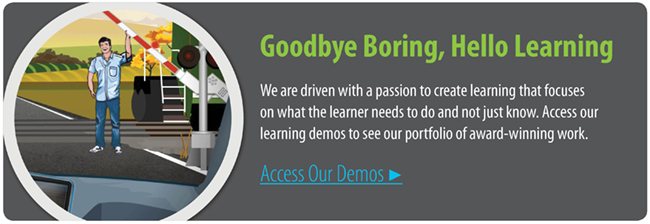Blog
Gamify Your e-Learning Solutions: A Trend 20 Years in the Making
By Angel Green, senior instructional strategist | @LearnerAdvocate Last week, I hosted a webinar on the Gamification of e-Learning. In this webinar, ...


Gamification for e-Learning Q&A
By Angel Green | March 06, 2014 | Custom Learning | 0 Comments

By Angel Green, senior instructional strategist | @LearnerAdvocate

Last week, I hosted a webinar on the Gamification of e-Learning. In this webinar, I discussed how instructional designers and organizations can (and should) incorporate game mechanics and design into their training programs. To help facilitate this process, I presented the Allen Interactions Taxonomy Alignment for Gaming (TAG). TAG is a model, based on Bloom’s Taxonomy, which helps instructional designers and organizations begin to brainstorm game types based on learner and organizational needs.
During the webinar, I paused several times for question and answers, and I wanted share several of the questions that were asked and my responses to them.
SMEs develop content and love the e-read format. How do you introduce them to games? —Alice
Alice, I hope you know you’re not alone! I’m not sure there is an instructional designer that I’ve met who can’t share a story of a time when a Subject Matter Expert (SME) went “content crazy” on a course. It happens to all of us. But, we have to demonstrate that we, as instructional designers, are the experts on how adults learn and what motivates them to change performance. Now, this means we actually have to do some homework ourselves, staying abreast of new research, participating in continuing professional development, etc. We have to be consultants and offer them insight on these topics.
We have to believe strongly enough to convince others that people won’t just read content and apply it to their job unless they are motivated to do so. Then, we have to learn how to increase learner motivation and engagement in the courses they are taking. If you need proof or to do some background investigation yourself, there is no shortage of things for you to review. There is an abundance of reliable white papers, peer-reviewed scholarly articles, books, and research reports that point to evidence of how game play engages the mind, several of which I sited in the Practitioner’s Guide to TAG, which was part of the webinar package.
If your SMEs really want to ensure their content is available to employees, you can also suggest alternative delivery formats of that content. One of the major advancements in the modern corporate environment is the mechanisms by which we are now able to share content. While once an e-learning course packaged on the LMS was a reliable method of sharing version-controlled content source, today’s corporations have many other, better-suited methods of content sharing. These include portals, SharePoint sites, intranets, and other server-based document repositories. There are even really cool, interactive methods of allowing learners to navigate through content, such as infographics, interactive timelines, or even 3D exploration experiences. The benefit of holding content in these places, rather than in an e-learning course, is two-fold:
- First, you reduce the burden on the learner. These delivery mechanisms are often easier to search and navigate, they are easier to access, and they are (usually) readily available from multiple platforms.
- Second, you reduce the burden on maintenance. When a new version of the document is available, you replace the old one. You don’t have to spend time and money updating an e-learning course containing all this information.
How did your clients know if the games were successful in changing employee’s behavior vs. instructor-led training or boring e-learning? —Nancy
Ah, the coveted measurement question. We have a few very strong examples of when clients measured existing business metrics before and after the implementation of a new approach to training. Essilor, the world’s leading eyeglass lens manufacturing company, is an example of measured success. Essilor saw approximately 7 million dollars in annual savings of lab breakage and error-redos at their plants after implementing a blended training initiative. AutoNation is another prime example where we were able to take a pilot group through the new training experience and leave a control group in the existing 100% ILT training. The pilot group outshined the control group on every measure. We have a case study on this program available here.
How do you justify costs for gaming it up when text-based can work? —Melissa
Well, I suppose if you genuinely believe that text-based can work to change the performance of the learner, then it would be a difficult justification. There is a wealth of research on human behavior and motivation that points to the fact that unless a learner is intrinsically motivated to learn the content and understands how he/she can apply that knowledge to the behavior you are looking for, they likely won’t. In my answer to Alice, I suggest alternative methods by which organizations might share content with an audience that are better suited for information sharing. We believe that e-learning (and all training in a corporate environment) should be focused on getting people to do the right thing at the right time. And, that training events need to focus on performance, not on content. When you believe in those, then you look for ways to provide instructional interactivity in your courses—the gaming methods in the webinar align very nicely with our CCAF-based Design Model consisting of Context, Challenge, Activity, Feedback.
Of course, if it’s just a matter of semantics (if you feel the word game has some negative connotations of being too frivolous for the work environment), you can call these “activities”, "interactions” or, in some cases, “role-plays.”
I hope the answers helped clarify some of the great questions we had during the webinar. If you are interested in getting access to the on-demand webinar and Practitioner’s Guide to TAG, you can find it here. To learn more about how to build the type of games we discussed, you can access the popular on-demand Serious Games for e-Learning webinar delivered by Steve Lee.
Great webinar from Allen Interactions on Gamification of eLearning! If you are interested in training, check them out #gameforchange
— Chris Fought (@cfought) February 26, 2014
#gameforchange @customlearning Things I love about Allen Interactions: Real Value, Innovative Thinking, Clear Communication, No B.S.
— Matt McCrorey (@eLearningMaker) February 26, 2014
#gameforchange Thank you for an informative webinar!
— June Watkins (@OfficiantJuneW) February 26, 2014



About the Author: Angel Green
Angel Green is a senior instructional strategist for Allen Interactions’ Tampa studio, where she is responsible for providing consultation and instructional design expertise to clients, partnering to build engaging, interactive learning experiences. With nearly 15 years of experience, Angel has worked for organizations such as IBM, MetLife, and PricewaterhouseCoopers, and holds both MS and BS degrees from Florida State University. An accomplished speaker, Angel has held positions as an adjunct instructor of public speaking and is past president of a Toastmasters International chapter. She also frequently blogs on Allen Interactions’ e-Learning Leadership Blog. Angel is the co-author of the Leaving ADDIE For SAM Field Guide. Find Angel on Google+.
Comments
Would you like to leave a comment?
Related Blog Posts

By: Angel Green | Feb, 2014
Category: Custom Learning, Strategic Consulting

Blog
10 Reasons Why You Should Attend the Allen Interactions User Conference
By Angel Green, senior instructional strategist | @LearnerAdvocate Last week, I hosted a webinar on the Gamification of e-Learning. In this webinar, ...
By: Angel Green | Jul, 2014
Category: Custom Learning, Digital Engineering, Strategic Consulting

Blog
40+ Game Design Resources for IDs, Trainers, Educators & Practitioners
By Angel Green, senior instructional strategist | @LearnerAdvocate Last week, I hosted a webinar on the Gamification of e-Learning. In this webinar, ...
By: Angel Green | Mar, 2015
Category: Custom Learning
